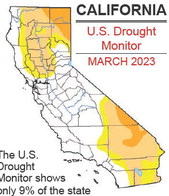Gov. eases restrictions but impacts linger


DROUGHT UPDATE
California Gov. Gavin Newsom issued an order easing restrictions related to the drought emergency March 24 after a winterlong string of storms has replenished reservoirs in the wake of the three driest years on record.
He did not declare an end to the drought, but the state will no longer ask people to voluntarily cut their water use by 15%, a request the governor first made nearly two years ago.
While recent storms have helped ease drought impacts, regions and communities across the state continue to experience water supply shortages, especially communities that rely on groundwater supplies that have been severely depleted in recent years. Last week’s order:
• Ends the voluntary 15% water conservation target, while encouraging Californians to make conservation a way of life.
• Ends the requirement that local water agencies implement Level 2 of their drought contingency plans.
• Maintains the ban on wasteful water uses, such as watering ornamental grass on commercial properties.
• Preserves all current emergency orders focused on groundwater supply, where the effects of the multi-year drought continue.
• Maintains orders focused on spe- cific watersheds that have not benefited as much from recent rains, including the Klamath River and Colorado River basins, which both remain in drought.
• Retains a state of emergency for all 58 counties to allow for drought response and recovery efforts to continue.
This order will impact people in different ways depending on where they live. For most people, it means they won’t be limited to watering their lawns on only certain days of the week or at certain times of the day.
Newsom was able to ease restrictions in part because state officials have reported that California’s reservoirs are so full they will more than double the amount of drinking water cities will get this year compared to a previous allocation announced last month.
Three years of little rain or snow have depleted reservoirs to the point the state couldn’t generate electricity from hydroelectric power plants.
It dried up wells in rural areas and state officials had to truck in water supplies for some communities. And it reduced the flow of the state’s major rivers and streams, killing off endangered species of fish and other species, according to Gov. Newsom.
But since December, no fewer than 12 powerful storms have hit California, packing so much rain and snow that meteorologists call them “atmospheric rivers.” These storms have flooded homes, closed ski resorts and trapped people in mountain communities for days with no electricity, prompting emergency declarations from President Joe Biden.
The storms have also filled most state reservoirs. Of California’s 17 major reservoirs, 12 of them are either at or above their historical averages for this time of year.
And more water is coming. Statewide, the amount of snow piled up in the mountains is already 223% above the April 1 average, the date when the snowpack is typically at its peak. Most of that snow will melt in the coming months, flowing into reservoirs and posing more flooding threats downstream.
The U.S. Drought Monitor reported last week that much of the state—including the major population centers along the coast and farmland in the Central Valley—are not in drought.
California doesn’t have enough room in its reservoirs to store all of the water from these storms. In fact, some reservoirs are having to release water to make room for new storms coming next week and snowmelt in the spring.
That’s why the Newsom administration has given farmers permission to take water out of the rivers and flood some of their fields, with the water seeping back under ground to refill groundwater basins.
—from the Office of the Governor at CA.gov and news reports



